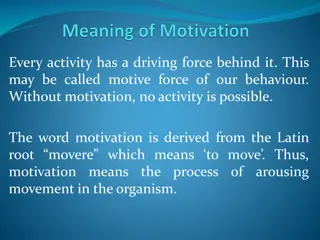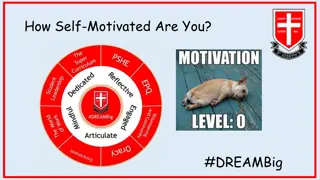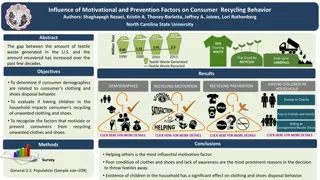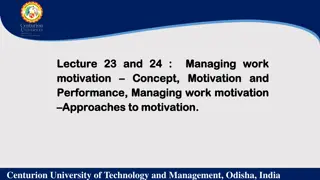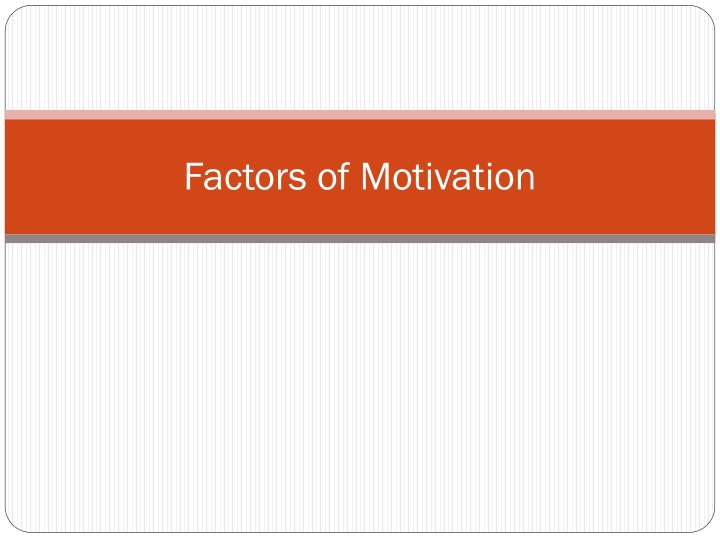
Enhancing Workplace Motivation: Factors and Strategies
Discover the vital factors of motivation and how they influence employee performance. Dive into leadership styles, recognition, and other key elements to boost motivation in your team effectively.
Download Presentation

Please find below an Image/Link to download the presentation.
The content on the website is provided AS IS for your information and personal use only. It may not be sold, licensed, or shared on other websites without obtaining consent from the author. If you encounter any issues during the download, it is possible that the publisher has removed the file from their server.
You are allowed to download the files provided on this website for personal or commercial use, subject to the condition that they are used lawfully. All files are the property of their respective owners.
The content on the website is provided AS IS for your information and personal use only. It may not be sold, licensed, or shared on other websites without obtaining consent from the author.
E N D
Presentation Transcript
Factors of Motivation Factors of Motivation Factors of motivation are strategies, incentives, recognitions and any other elements that increase an employee's overall motivation to perform their duties at work. You can implement several different factors of motivation within your team or for yourself to increase productivity and satisfaction. However, because each person is different, it's important to first take time to better understand what motivates specific groups of employees. For example, some employees may be motivated by bonus incentives, while others may find motivation in the opportunity to gain more paid-time-off (PTO) days.
Motivation refers to the process that guides and maintains behaviors that help employees work towards a particular goal or effectively perform tasks. The most common types of motivation include: Extrinsic motivation: This type of motivation refers to factors that are outside of the person, such as bonuses, social recognition and praise. Intrinsic motivation: Intrinsic motivation is a type of motivation that occurs within the individual. For example, personal gratification and a feeling of accomplishment are two types of intrinsic motivations.
13 factors of motivation 13 factors of motivation 1.Leadership style Supervisors, managers and other leaders within a company play a significant role in their employees' motivation. The appropriate leadership styles encourage employees to develop objectives and goals in their positions, work towards those goals and help employees maintain that motivation throughout the course of their time at the organization. To be effective, leaders must determine the best leadership styles for each type of employee, as not all employees respondwell to all leadership styles. The most common leadership styles include: Autocratic Democratic Coaching Authoritative Affiliative Laissez-faire Transformational Servant Understanding these styles and catering your leadership style to your team's needs ensures you effectively motivate them in the workplace.You can also let your manager know the type of leadership style that best motivates you to help them be a better leader and keep you motivated.
2.Recognition and appreciation Appreciation and recognition are two important components of motivation within an organization. Offering recognition and praise not only makes employees feel accomplished and appreciated, but it also reinforces good performance and encourages employees to continue repeating the actions that led to the performance. The more employee behavior is positively recognized,the more likely they are to repeat these behaviors and remain motivated in the workplace.
3.Meaning and purpose Employees who find a sense of meaning and purpose in their work often have higher levels of motivation than those who don't. Employees want to know that what they do is actually contributing to the organization's success and that their duties and accomplishments support the company's overall growth. It's helpful to ensure you understand how your role plays an integral part in your company's processes and success and that your work has meaning beyond simply completing tasks on time to earn a paycheck.
4.Positive company culture A company's culture can greatly impact employee motivation in the workplace. Many employees feel more valued and enjoy their work more when there is a strong company culture that supports employees and brings them together on a regular basis. Areas to focus on when increasing the positivity of company or team culture include the wellbeing of employees, inclusion and equality among employees and compassion towards employees. You can also contribute positively as an employee and get more involved with your company's culture to keep yourself motivated.
5.Professional development opportunities Employees often feel more motivated at work when there are ample opportunities for development. Giving employees opportunities to increase their skills and become more efficient in their positions instills a sense of accomplishment and pride that acts as a strong motivator for employees. Plus, offering employees the chance to hone their skills can ultimately impact an organization's overall success, making it a win-win situation for all involved. growth and professional
6.Job advancement opportunities Another way in which employees become more motivated in the workplace is when a clear path of job advancement is emphasized. Employees who feel that they are stuck in one position and have no opportunity to grow within a company are more likely to become burnt out and look for other job opportunities. Ensuring employees understand a clear plan of progression within their position in the workplace can instill motivation to work towards a promotion, which can ultimately increase employee productivity. If you're unsure whether you have opportunities to advance, speak with your manager and inquire about what's available to you.
7.Financial benefits While financial benefits aren't a motivator for all employees, they can enhance many employees' overall motivation in the workplace. Putting in place different opportunities for employees to enjoy financial benefits for hard work is a great way to boost motivation and give employees a sense of accomplishment and appreciation. Examples of financial motivators include bonuses, raises, promotions, competitive benefits packages and additional paid time off.
8.Flexible work schedules Offering employees the opportunity to create their own schedules or work flexible hours is another great way to instill motivation in your team. Flexible schedules allow employees to better accommodate family needs, holidays and other personal daily responsibilities that more rigid schedules often don't. For example, some employees work better in the mornings, while others do their best work in the afternoons or evenings. Giving them the option to choose their schedules allows employees to set up their workday in a way that is conducive to their preferences and needs and can keep employees motivated to accomplish their daily work goals.
9.Pride Most employees want to feel proud of the work they complete and themselves as members of an organization. Team leaders can create a work environment that offers employees opportunities to feel proud of their work on a regular basis, which can ultimately promote increased motivation and productivity.
10.Open communication When employees feel that they can openly communicate with other employees and management, they are often more motivated in the workplace. Feeling closed off from others can lead to feelings of isolation and leave employees questioning if management cares about their success. Ensuring there is an open line of communication among employees of all levels can help alleviate issues quickly, encourage employees to experiencing challenges and keep employees motivated by fostering a sense of connection. communicate when they're
11.Staying up-to-date on company matters Keeping employees up-to-date on the latest company matters ensures that they feel part of something larger than just their day-to-day job.Rather than simply going to work to receive a paycheck, employees who organization are more likely to enjoy their work and feel a sense of motivation in supporting the organization's success. Taking time each week or month to inform team members of the organization's latest information is a great way to keep everyone up-to-date and ensure employees are engaged within the workplace. feel connected to their
12. Job security Employees are often more motivated when they know they have job security with a company. It's important to regularly inform team members of their job security and to know that they are a valuable asset to the company. 13. A positive work environment Similar to a positive work culture, a positive work environment can also increase employee motivation. Work environment refers to both physical and non-physical factors that directly impact the environment of the workplace. Creating open spaces that entice the senses, implementing specific areas of the workplace that are committed to the wellbeing of employees and allowing employees to communicate with each other throughout the day can all work to increase motivation in a team.



